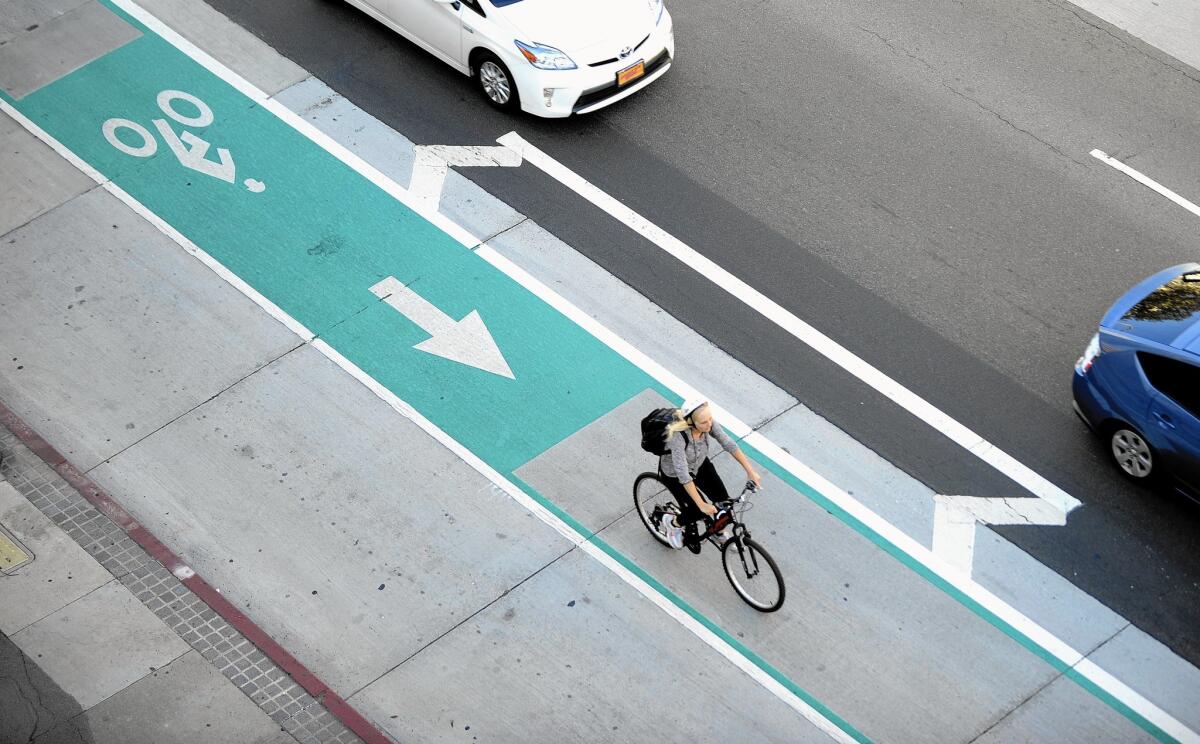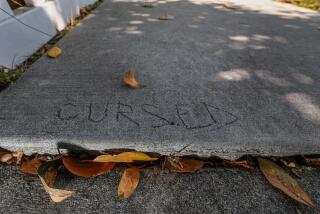L.A’s road diet leaves some hungry for workable solutions

A cyclist uses a bike lane in downtown Los Angeles. Mobility Plan 2035, a sweeping transportation policy approved by the City Council, seeks to shift the city’s emphasis away from the automobile.
- Share via
When we talk about traffic in Los Angeles, we generally bicker about how slowly it moves, and we demand to know when someone at City Hall is going to do something about it.
Well, city officials have finally responded, but not in the way you might have expected.
On many streets, they’re trying to slow traffic down, not speed it up.
Mobility Plan 2035, which detractors are referring to as the Immobility Plan, is a citywide initiative to add more bus-only and bike lanes over the next 20 years, often at the cost of removing vehicle lanes. Sunset, Venice and Lankershim boulevards are among the major thoroughfares that could get both bus and bike lanes.
See the most-read stories this hour >>
“Road diet” is the operative term, and if the city goes forward with its plan, everything you do — from commuting, to running errands, to taking the kids to school — will be affected for decades to come. As my colleague David Zahniser wrote, “The goal is to improve safety for cyclists and pedestrians while also luring more people out of their cars.”
Not surprisingly, cyclists and backers of pedestrian-oriented planning are cheering.
Critics are crying about pollution from idling vehicles, potential emergency vehicle delays, accident risks and new headaches as motorists cut through residential streets to avoid road-diet backups. A Westside nonprofit called Fix the City has sued to overturn the plan, which won City Council approval in August by a 12-2 vote.
I happen to live in a neighborhood that has served as one of the early test cases for the plan, and I’ve got friends and neighbors who love it or loathe it. I see some good points on both sides of the argument, but clearly the city didn’t do enough homework before ripping out two vehicle lanes on a major thoroughfare.
Three years ago, a 24-year-old woman left a Silver Lake restaurant and crossed Rowena Avenue to meet her father, who was waiting in his car. She was not in a crosswalk. One motorist stopped for her, but another apparently didn’t see her, and the woman was struck and killed.
The accident accelerated a plan to make Rowena safer by transforming it from four lanes of traffic to two lanes, with a center buffer and bike lanes.
And the result?
At a packed community meeting Monday night, called by the Silver Lake Neighborhood Council, reps from the city’s transportation department said that there had been several fewer traffic accidents and that average speeds of most vehicles have decreased by up to three miles an hour.
The rundown of these benefits drew lots of atta-boys from road diet fans: cyclists, pedestrians and residents, including an 11-year-old student who talked about feeling safer while pedaling to Ivanhoe Elementary School in a dedicated bike lane.
And the bad news?
Traffic on Rowena can be hellish at rush hour, so I and a lot of other impatient motorists avoid it by taking alternate routes through narrow streets that weren’t built to accommodate the added flow.
Naturally, residents of those streets don’t like it. They say drivers are blowing through stop signs, speeding, killing the occasional cat and cursing at least one woman who has tried to slow them down.
“We’re all for cyclists having safety, we applaud it,” said one homeowner. “But what you’ve gained in safety, we’ve lost.”
And as one exasperated resident noted, when you keep increasing the number of housing units while decreasing the number of traffic lanes, you’re inviting these kinds of problems.
Resident Jerome Courshon, for one, was ticked off that the city scarcely considered such issues in a brief study, then “snuck in” the road diet without much community input. How can you even call it a study, he asked the transportation officials, “when you don’t take into account one of the most severe impacts?”
Tim Fremaux of the transportation department said that in Silver Lake, the city studied what it was legally required to study, but maybe not what it should have studied.
“We have by no means done this flawlessly,” he said. “There were errors along the way.”
The transportation staff said it will look into possible fixes for the cut-through problems. A crackdown on traffic violations might help, and there are all sorts of “traffic calming” tools, including islands and speed bumps.
But speed bumps are already on hold because of budget constraints.
The broader question, for Silver Lake and the rest of Los Angeles, is what kind of city do we want to live in, and are there compromises everyone can agree on?
At Monday’s meeting, one speaker asked why there can’t be DASH-style neighborhood shuttles to get people out of their cars.
Good idea, especially in Silver Lake. I think a DASH to Trader Joe’s would cut traffic by about 80%, especially if it was free for anyone with tattoos or hightops.
Another good idea: one resident wondered why the school district isn’t more involved in the walking-cycling discussion, given the huge volume of traffic created by parents driving students to and from school daily.
Courshon said he’d love to see more Main Street kinds of neighborhoods where people can safely bike and stroll. But he feels as though City Hall is using road diets to force people out of their cars before making transit more accessible and bike lanes safer and more connected than they are now.
Resident Don Ward, on the other hand, likes the road diet. After decades of planning for and spending billions building a car-dominated culture, he said, the only way out of the mess we’ve created is to slow traffic and build a city in which walking, cycling and public transit are more efficient if not preferable options.
Courshon and Ward met over a few beers recently to see if they could find any common ground, and they reached a tentative “pact.” It involves taking Rowena off its diet. It would go back to two lanes in each direction between Glendale and Hyperion, but with two additional crosswalks with signals to make the corridor slower and safer. And as a trade, bike lanes would be added to nearby Hyperion Avenue.
Not a bad idea, and more importantly, there’s a lesson here.
When city officials come snooping around your neighborhood with plans for a road diet, don’t assume they’re going to do their homework. Get involved. Ask questions. Work out your own compromises.
It’s your city, not theirs.
MORE FROM STEVE LOPEZ:
A new skirmish in the battle for Malibu beach access
At 62, mourning a high school girlfriend killed in car crash
Cautionary tales for baby boomers without enough money for retirement
More to Read
Sign up for Essential California
The most important California stories and recommendations in your inbox every morning.
You may occasionally receive promotional content from the Los Angeles Times.










